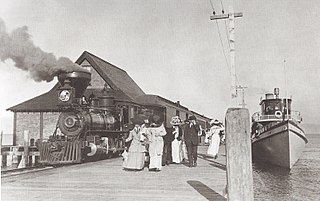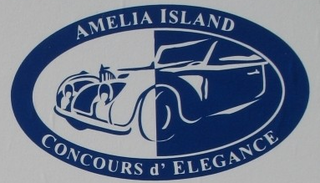
A personal watercraft (PWC), also called water scooter or jet ski, is a recreational watercraft that a rider sits or stands on, not within, as in a boat. PWCs have two style categories, first and most popular being a runabout or "sit down" where the rider uses the watercraft mainly sitting down, and the watercraft typically holds two or more people. The second style is a "stand-up", where the rider uses the watercraft standing up. The stand-up styles are built for one rider and are used more for doing tricks, racing, and use in competitions. Both styles have an inboard engine driving a pump-jet that has a screw-shaped impeller to create thrust for propulsion and steering. Most are designed for two or three people, though four-passenger models exist. Many of today's models are built for more extended use and have the fuel capacity to make long cruises, in some cases even beyond 100 miles.
Boat racing is a sport in which boats, or other types of watercraft, race on water. Boat racing powered by oars is recorded as having occurred in ancient Egypt, and it is likely that people have engaged in races involving boats and other water-borne craft for as long as such watercraft have existed.

Boating is the leisurely activity of travelling by boat, or the recreational use of a boat whether powerboats, sailboats, or man-powered vessels, focused on the travel itself, as well as sports activities, such as fishing or waterskiing. It is a popular activity, and there are millions of boaters worldwide.

The El Toro is a one-design class of sailing dinghy. The El Toro is quite small—approximately 8 feet (2.44 ) long—and very simple to sail.
The Pebble Beach Concours d'Elegance is an automotive charitable event held each year on the Pebble Beach Golf Links in Pebble Beach, California. It is widely considered the pinnacle event of its kind and one of the most prestigious car events in the world.

Concours d'Elegance is a term of French origin that means a "competition of elegance" and refers to an event where prestigious vehicles are displayed and judged. It dates back to 17th-century France, where aristocrats paraded horse-drawn carriages in the parks of Paris during summer weekends and holidays. Over time, carriages became horseless and the gatherings became a competition among vehicle owners to be judged on the appearance of their vehicles. These events are often held at automobile shows, after racing competitions or, especially in the United States, as a fundraising event for charities.

SS Tahoe was a steamship that operated on Lake Tahoe at the end of the 19th century and the first half of the 20th. Scuttled in 1940, the wreck presently lies in 400 feet (120 m) of water off Glenbrook, Nevada. The wreck was first visited in 2002 by a team from New Millennium Dive Expeditions (NMDE) in a record-setting high-altitude dive for Lake Tahoe. As a result of the work that NMDE did on the Tahoe site from 1999 up to their dives in 2002, Tahoe became the first maritime site in Nevada to be listed in the National Register of Historic Places.
Fairey Marine Ltd, latterly known as FBM Marine, was a boat building company based on the River Hamble, Southampton, England. The company was created in the late 1940s by Sir Charles Richard Fairey and Fairey Aviation's managing director, Mr. Chichester-Smith. Both were avid sailing enthusiasts along with Chichester-Smith's good friend and former Olympic yachtsman, Charles Currey.
Charles Drown Mower of New York was a noted yacht designer and author, and was at one time design editor of the Rudder magazine and a contributing author to Motor Boating magazine.
Stephens Brothers Boat Builders and Designers company, an American boat designer, began in the back yard of brothers Theodore and Robert Stephens. Their boatbuilding firm in Stockton, California operated from 1902 to 1987. Over the years the company became famous for its elegantly designed pleasure craft, including sailboats, speedboats, cruisers and private yachts. Stephens Bros. also built many vessels for the U.S. military, especially during World War II. The company's first vessel was the sloop Dorothy, in 1902.
Hinckley Yachts, founded in 1928, manufactures, services and sells luxury sail and powerboats. The company is based in Maine, United States. The company has developed yacht technologies including JetStick and Dual Guard composite material, and was an early developer of the fiberglass hull. Currently, Hinckley operates service yards in seven locations along the east coast of the United States, making it one of the most integrated boating concerns in the United States. Hinckley’s present yacht line includes boats ranging in size from 29 to 55 feet. All of Hinckley’s yachts are built to order with customization of the interior and exterior cosmetics as required by the purchaser.

The Amelia Island Concours d'Elegance is an automotive charitable event held each year during the second weekend in March at The Ritz-Carlton Amelia Island in Amelia Island, Florida. A The New York Times article about celebrity car ownership listed "the nation's top concours d'elegance: Pebble Beach in California, Meadow Brook in Michigan, Amelia Island in Florida and the Louis Vuitton Classic in midtown Manhattan."
Hornblower Cruises & Events NOW City Experiences is a San Francisco-based charter yacht, dining cruise and ferry service company.

Hacker-Craft is the name given to boats built by The Hacker Boat Co. It is an American company, founded in Detroit, Michigan in 1908 by John Ludwig Hacker and is the oldest constructor of wooden motor boats in the world. The company moved operations to New York State in the 1970s and continues to produce hand-built boats in Ticonderoga, near Lake George, with corporate offices, storage facilities and a marina lakeside in Silver Bay.
The Kirkland Concours d'Elegance at America's Car Museum is an automotive charitable event which has raised approximately 1.5 million US dollars during its first nine years for uncompensated health care for children at Seattle Children's Hospital and Evergreen Hospital Medical Center. The event was established in 2003 and was held the first nine years of its existence at Carillon Point in Kirkland, Washington. In September 2012 the event moved to the LeMay America's Car Museum (ACM) in nearby Tacoma, and held until 2013 when LeMay ACM decided to end the event.
The Les Cheneaux Antique Wooden Boat Show is held in the Upper Peninsula of Michigan in the city of Hessel, Michigan. Founded in 1978, the event is held every year during the second week of August. The event brings about 8,000 to 10,000 boaters and visitors each year from all over the United States coming together to appreciate antique boats. The boats featured in the event include dinghies, rowboats, canoes, launches, sailboats, utilities, runabouts and large cruisers. On average there are about 150 boat entries each year. Along with the boat show there is The Festival of Arts.

Rosinco was a diesel-powered luxury yacht that sank in Lake Michigan off the coast of Kenosha, Wisconsin in 1928. The yacht was built in 1916 as Georgiana III and served during World War I as USS Georgiana III, a Section patrol craft, under a free lease to the Navy by her owner and commanding officer. After the war the yacht was sold and renamed Whitemarsh in 1918. In 1925, after sale to Robert Hosmer Morse of Fairbanks-Morse, the yacht became Rosinco. She was sunk following a collision in 1928 and the wreck was added to the National Register of Historic Places in 2001.

Balboa Yacht Club (BYC) is a yacht club located in Corona del Mar, Newport Beach, Orange County, California. It is located near the entrance of the Newport Harbor.
The UIM-ABP Aquabike World Championship is a powerboating sports competition. The UIM-ABP Aquabike World Championship is the premier class of jetski racing, founded in 1992. Aquabike jetskis are personal watercraft vehicles purpose-built for racing and modified according to class. The UIM-ABP Aquabike World Championship is organized and promoted by H2O Racing Ltd on behalf of the Union Internationale Motonautique (UIM), the governing body of powerboating and the exclusive entity recognized by the International Olympic Committee (IOC). ABP refers to Aquabike Promotion.

The Gar Wood Speedster is a model of 16 ft racing boat produced and offered from 1934 to 1938 by Garfield Wood under the "Gar Wood" brand, and powered with various single six-cylinder flathead marine engines. Of the fourteen original Speedsters, three have been widely researched due to their famous owners – "Miss Behave" and "Miss Chief" from 1935, and "Miss Persia" from 1936. Today, more reproduction Speedsters than original boats exist worldwide, with reproductions starting as early as the 1960s.













